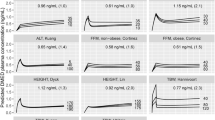Summary
Sixteen anesthetized foxhounds were instrumented for hemodynamic measurements. The adrenolumbar vein was cannulated, and hemorrhagic hypotension (MAP=40 mmHg for 3 h) was induced by bleeding. The plasma levels ofβ-endorphin (β-END), methionine-enkephalin (M-ENK), and leucine-enkephalin (L-ENK) were determined in systemic and adrenal venous blood by specific RIA. Five dogs received an i.v. bolus of naloxone (2 mg/kg) and a subsequent naloxone infusion of 2 mg/kg per hour 1 h after onset of hypovolemia. Eleven dogs served as controls and received equivalent volumes (1 ml/kg per hour) of saline.
Hemorrhage resulted in a sharp increase in plasma concentrations of all measured opioid peptides, particularly of M-ENK (26-fold) and L-ENK (24-fold) in the adrenal effluent. Systemicβ-END levels remained 3-fold increased, whereas the ENK release decreased spontaneously. Naloxone treatment inhibited the spontaneous fall of adrenal ENK release during the hypotensive phase; the ENK values remained elevated 20- to 35-fold. Reinfusion of the autologous blood resulted in a normalization of the concentrations of all peptides in both groups.
These data demonstrate that hemorrhagic hypotension will cause stimulation of release of endogenous opioid peptides. The high levels of ENK in the adrenal effluent indicate that the adrenal gland is the main source of these peptides in the circulation. In addition toβ-END, the ENK have therefore to be considered as possible factors perpetuating circulatory shock.
Similar content being viewed by others
References
Brückner UB, Lang RE, Witt M, Ganten D (1982) Naloxone effects and plasma levels of opioid peptides in traumatic-hemorrhagic shock. [Abstr] Langenbecks Arch Chir 357:175
Curtis MD, Lefer AM (1980) Protective actions of naloxone in hemorrhagic shock. Am J Physiol 239:H416-H421
Dirksen R, Otten MH, Wood GJ, Verbaan CJ, Haalebos MMP, Verdouw PV, Nijhuis GMM (1980) Naloxone in shock. Lancet II:1360–1361
Dirksen R, Wood GJ, Nijhuis GMM (1981) Mechanism of naloxone therapy in the treatment of shock: A hypothesis. Lancet 1:607–608
Estilo AE, Cottrell JE (1982) Hemodynamic and catecholamine changes after administration of naloxone. Anesth Analg (Cleve) 61:349–353
Faden AI, Holaday JW (1980) Experimental endotoxin shock: The pathophysiologic function of endorphins and treatment with opiate antagonists. J Infect Dis 142:229–238
Gurll NJ, Vargish T, Reynolds DG, Lechner RB (1981) Opiate receptors and endorphins in the pathophysiology of hemorrhagic shock. Surgery 89:364–369
Hess ML, Smith JM, Eaton LR, Kleinmann W, Okabe E (1981) Chronic opiate receptor occupation and increased lethality in endotoxemia. Circ Shock 8:313–322
Holaday JW, Faden AI (1978) Naloxone reversal of endotoxin hypotension suggests role of endodorphins in shock. Nature 275:450–451
Hughes J, Kosterlitz HW, Smith TW (1977) The distribution of methionine-enkephalin and leucine-enkephalin in the brain and peripheral tissues. Br J Pharmacol 61:639–647
Kamakura K, Karoum F, Guidotti A, Costa E (1980) Modulation of nicotinic receptors by opiate receptor agonists in cultured adrenal chromaffin cells. Nature 283:489–492
Peters WP, Johnson MW, Friedman PA, Mitch WE (1981) Pressor effect of naloxone in septic shock. Lancet 1:529–532
Raymond RM, Harkema JM, Stoffs WV, Emerson TE (1981) Effects of naloxone therapy on hemodynamics and metabolism following a sublethal dosage ofEscherichia coli endotoxin in dogs. Surg Gynecol Obstet 152:159–162
Reynolds DG, Gurll NJ, Vargish T, Lechner RB, Faden AI, Holaday JW (1980) Blockade of opiate receptors with naloxone improves survival and cardiac performance in canine endotoxic shock. Circ Shock 7:39–48
Schadt JC, York DH (1981) The reversal of hemorrhagic hypotension by naloxone in conscious rabbits. Can J Physiol Pharmacol 59:1208–1213
Schultzberg M, Lundberg JM, Hökfelt T, Brandt J, Elde RP, Goldstein M (1978) Enkephalin-like immunoreactivity in gland cells and nerve terminals of the adrenal medulla. Neuroscience 3:1169–1186
Swinburn WR, Phelan P (1982) Response to naloxone in septic shock. Lancet 1:167
Vargish T, Reynolds DG, Gurll NJ, Ganes EM, Lutz SA (1982) The interaction of corticosteroids and naloxone in canine hemorrhagic shock. J Surg Res 32:289–295
Viveros OH, Diliberto EJ, Hazum E, Chang K-J (1979) Opiate-like materials in the adrenal medulla. Evidence for storage and secretion with catecholamines. Mol Pharmacol 16:1101–1108
Yang H-YT, Hexum T, Costa E (1980) Opioid peptides in adrenal glang. Life Sci 27:1119–1125
Author information
Authors and Affiliations
Rights and permissions
About this article
Cite this article
Brückner, U.B., Lang, R.E. & Ganten, D. Release of opioid peptides in canine hemorrhagic hypotension: Effects of naloxone. Res. Exp. Med. 184, 171–178 (1984). https://doi.org/10.1007/BF01852391
Received:
Accepted:
Issue Date:
DOI: https://doi.org/10.1007/BF01852391




